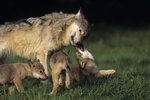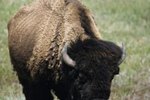
Most people grow up hearing about how a particular animal is an endangered species. Many times researching the animal brings up a small infograph listing it as endangered, threatened, vulnerable or other terms related to it. The three most common descriptors, endangered, threatened and vulnerable, don't necessarily mean the same thing.
Vulnerable
A species classified as vulnerable faces threats, like loss of habitat and poaching, in the wild that may cause it to go extinct. These species have come under threats that have pushed them out of near threatened and into the first of the IUCN's danger-zones: vulnerable. The threat of extinction for vulnerable creatures, like the African lion, remains higher than for species of least concern while near threatened species are approaching its status or kept stable via captive breeding programs. In other words, near threatened species' problems have intensified or continued so their population has decreased to a worrisome level; they are now vulnerable.
Endangered
Endangered species populations are in severe decline and are at risk for extinctions based on several factors, such as pollution, deforestation and hunting. One notable example of this has been the bald eagle. Once highly endangered in the 1980s and early 90s due to DDT poisoning, conservation efforts have since worked so the species is classified as least concern today.
Critically Endangered
Critically endangered species are those that are almost extinct in the wild. Their numbers have become so few that they may have trouble breeding to keep the entire species viable without help from conservationists. In other words, they cannot find mates to produce young, or they take such a long time to mature that they often die before they can reproduce. By capturing members of the wild population to raise them in captivity and breed them there for later release back into the wild, conservationists try to keep the species alive. The Western gorilla falls into this category and has had rigorous conservation efforts undertaken to bolster its wild population; it remains critically endangered as wild populations continue to decrease due to deforestation and poaching.
Threatened
The term "threatened" is not a category in itself but an umbrella term the IUCN uses to encompass all three of their levels of most concern: vulnerable, endangered and critically endangered. Any species that has entered these three categories is officially described as a threatened species overall, and one of the levels in particular. In order to become threatened, a species must have been observed decreasing in numbers over a period of time due to loss of habitat, over-hunting, poaching and pollution. The drop in population must be one that biologists and environmentalists note as detrimental to the species and which therefore places difficulties in its path to regaining those numbers without outside help.
References
Photo Credits
-
Jupiterimages/Photos.com/Getty Images
Writer Bio
Dondi Ratliff is a certified secondary English teacher in Texas. Her articles typically cover topics regarding animals both wild and domesticated. Ratliff holds a Bachelor of Arts in English from Tarleton State University, a Master of Arts in teaching from Texas Woman's University, and a Master of Arts in English from Tarleton State University.



